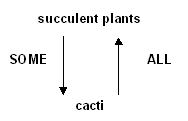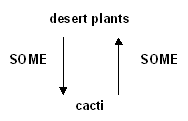
4.1 Semantic Linking | 4.2 Equivalency | 4.3 Hierarchy | 4.4 Associative
The use of hierarchical relationships is the primary feature that distinguishes a taxonomy or thesaurus from other, simple forms of controlled vocabularies such as lists and synonym rings.
Hierarchical relationships are based on degrees or levels of superordination and subordination, where the superordinate term represents a class or a whole, and subordinate terms refer to its members or parts. Reciprocity should be expressed by the following relationship indicators:
• BT (Broader Term), a label for the superordinate term
• NT (Narrower Term), a label for the subordinate termExample 101: Hierarchical relationship notation (BT and NT)
mammals
BT vertebrates
vertebrates
NT mammals
In the flat format controlled vocabulary (see Z39.19 section 9.3.4.1) BT and NT indicate one level broader and one level narrower, respectively. There are other types of displays that indicate multiple levels of hierarchy (see 5. Displaying Controlled Vocabularies).
Hierarchical relationships may also be indicated by systematic presentations such as tree structures or graphic displays (see 5.3.4 and 5.3.5).
Hierarchical relationships cover three logically different and mutually exclusive situations:
a) the generic relationship
b) the instance relationship
c) the whole-part relationship
Each of these types of relationships may apply to a single term. Special codes may be used to distinguish them.
Each of the relationships should lead to hierarchies that are amenable to a logical test (see Figure 6 and Figure 7 below) through reference to the basic types of concept represented by the terms, for example, those listed in Z39.19 section 6.3 Term Form.
Every subordinate term should refer to the same basic kind of concept as its superordinate term; that is, both the broader and the narrower term should represent a thing, an action, a property, etc. For example:
• anatomy (a discipline) and central nervous system (a body part that can be an object of study of that discipline) represent different kinds of concepts; therefore, these terms cannot be related hierarchically;
• central nervous system and brain both represent body parts; these terms can therefore be related hierarchically.
This relationship identifies the link between a class and its members or species. This type of relationship is often called “IsA." A simple way to apply the test for validity described above is to formulate the statement “[narrower term] is a [broader term].” This relationship is also amenable to a logical "all-and-some" test as shown in Figure 6:

Figure 6: All and some relationship – passes test
Figure 6 illustrates that some members of the class succulent plants are known as cacti and that all cacti, by definition and regardless of context, are succulent plants. Figure 7 illustrates a case where the "all-and-some" test is not met. While some members of the class desert plants are known as cacti, some, but not all, cacti are desert plants. These terms should therefore be assigned to different hierarchies in the controlled vocabulary, and both terms should be assigned to the same content object when indexing a work on "cacti as desert plants."

Figure 7: All and some relationship – does not pass test
4.3.1.1 Codes for the Generic Relationship (8.3.1.1)
The generic nature of a relationship may be identified by the BT/NT coding described above, or if more refined coding is desired for the various types of hierarchical relationship, by the following abbreviations:
• BTG = Broader term (generic)
• NTG = Narrower term (generic)Example 102: Generic relationship notation (BTG and NTG)
rats
BTG rodentsrodents
NTG rats
This relationship identifies the link between a general category of things or events, expressed by a common noun, and an individual instance of that category, often a proper name. This type of relationship is also known as an “IsA” relationship.
Example 103: Instance relationships
mountain regions
Alps
Himalayas
In the above example, the Alps and the Himalayas are assigned to subordinate positions in a hierarchy, yet they are neither kinds nor parts of mountain regions, but represent specific examples or instances.
4.3.2.1 Codes for the Instance Relationship (8.3.2.1)
The hierarchical instance relationship may be indicated by the following abbreviations:
• BTI = Broader term (instance)
• NTI = Narrower term (instance)Example 104: Instance relationship notation (BTI and NTI)
This relationship covers situations in which one concept is inherently included in another, regardless of context, so that the terms can be organized into logical hierarchies, with the whole treated as a broader term. This relationship can be applied to several types of term; the four types enumerated below are not intended to be exhaustive. In the following examples, parts are indicated through indention.
Example 105: Whole-part relationships – systems and organs of the body
Example 106: Whole-part relationships – geographic locations
Example 107: Whole-part relationships – hierarchical organizational, corporate, social, or political structures
4.3.3.1 Codes for the Whole-Part Relationship (8.3.3.1)
The hierarchical whole-part relationship may be indicated by the following abbreviations:
• BTP = Broader term (partitive)
• NTP = Narrower term (partitive)Example 108: Whole-part relationship notation (BTP and NTP)
central nervous system
BTP nervous systemnervous system
NTP central nervous system4.3.3.2 Parts of Multiple Wholes (8.3.3.2)
When a whole-part relationship is not exclusive to a pair of terms, i.e., the part can belong to multiple wholes, the name of the whole and its part(s) should not have a hierarchical relationship. Rather,
they should be linked associatively rather than hierarchically in the controlled vocabulary. Carburetors, for example, are parts of machines other than cars. Therefore, the appropriate relationship in this instance is cars RT carburetors.
When terms are arranged in hierarchies (such as tree structures) in a taxonomy, thesaurus, or Web navigation layout, node labels may be used to show the principles of division among a set of sibling terms (terms that share a broader term).
Although their function is similar to that of broader terms, node labels are not terms, and must not be used as indexing terms. They are often typographically distinguished from terms, e.g., through the use of italics and/or enclosure in angle brackets.
Example 113: Node labels in hierarchies
To be continued: | 4.4 Associative
| Table of Contents |
| 1. Why Vocabulary Control | 2. Principles | 3. Structures | 4. Semantic Relationships |
| 5. Displays | 6. When to use | 7. Examples of use | 8. About Z39.19 |
©NISO, 2005 http://www.niso.org/
Source: Based on ANSI/NISO Z39.19-2005 ISBN: 1-880124-65-3
Guidelines for the Construction, Format, and Management of Monolingual Controlled Vocabularies